24 Jan 2011
by Trager Water Report
in Use of water
Tags: California, California water, Delta, drought, water conservation
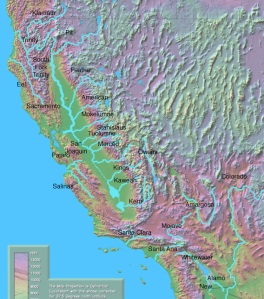 The powerful Westlands Water District recently withdrew its support for the Bay-Delta Conservation Plan, action that might light a fire under other water organizations in the state.
The powerful Westlands Water District recently withdrew its support for the Bay-Delta Conservation Plan, action that might light a fire under other water organizations in the state.
The bold action by Westlands indicates that it is no longer willing to put up with unwanted and unmerited federal interference in the conscientious efforts by water interests in California to make the best use of water.
Westlands’ concerns regarding political interference by the Department of the Interior and its creation of further water restrictions without scientific basis are well-justified. Among other questionable activities, this department has been criticized recently by federal and state legislators for holding secret meetings on its planning process and for manipulating science to support its drilling ban in the Gulf of Mexico, resulting in the loss of 12,000 jobs.
Read more…
18 Jan 2011
by Trager Water Report
in Use of water
Tags: California, California water, Delta, farm water, water conservation, water waste
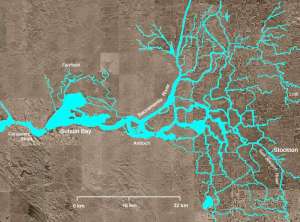 Delta Watermaster Craig Wilson will present a highly anticipated report to the State Water Resources Control Board on January 19 suggesting that a particularly contentious area of California water law, the California Constitution’s “Reasonable and Beneficial Use Doctrine,” be applied more broadly.
Delta Watermaster Craig Wilson will present a highly anticipated report to the State Water Resources Control Board on January 19 suggesting that a particularly contentious area of California water law, the California Constitution’s “Reasonable and Beneficial Use Doctrine,” be applied more broadly.
In his report, Wilson recommends that the State Board employ this doctrine to promote agricultural water use efficiency. The doctrine states a water right does not include the right to waste water and mandates that “the water resources of the state be put to beneficial use,” according to the Planning and Conservation League Insider (http://www.pcl.org).
A small percentage of increased agricultural water use efficiency adds up to significant water savings in California, according to Wilson. The report recommends that the State Board convene a “Reasonable Use Summit” to develop specific actions to improve efficiency and create a “Reasonable Use Unit” within the Division of Water Rights.
Read more…
10 Jan 2011
by Trager Water Report
in CA Delta
Tags: California water, Central Valley, Delta, Los Angeles, San Diego, Susan Trager
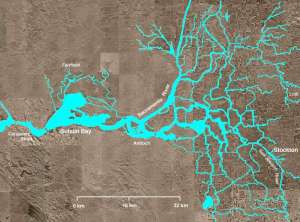 1,300 miles of ancient, earthen levees protect and encircle the Sacramento Delta. Some say this leaves the area, and its crucial water supply vulnerable to an earthquake. Others opine that the levees are sturdy enough. That something seemingly as simple as agreement over the safety of levees can’t be reached is a telling indication of how politically contentious the Delta is. It’s been this way for decades too.
1,300 miles of ancient, earthen levees protect and encircle the Sacramento Delta. Some say this leaves the area, and its crucial water supply vulnerable to an earthquake. Others opine that the levees are sturdy enough. That something seemingly as simple as agreement over the safety of levees can’t be reached is a telling indication of how politically contentious the Delta is. It’s been this way for decades too.
It’s all about the water, and who will control it and where will it go. Delta residents and environmentalists have somewhat overlapping interests. They want most of the water to stay in the Delta so the wildlife, fish, and birds will be protected and the area remains a natural resource. In opposition to them, but hardly allies, are farming interests in the Central Valley and the Los Angeles / San Diego water-devouring monsters to the South. Everyone wants that water, and more than a few of the players are politically connected with major financial resources. Add to that a multiplicity of federal, state, and local agencies with regulatory power over the Delta and you get a rather complicated game indeed, and one which is played using brass knuckles. The politics of water in California has always been a barely disguised street fight.
Read more…
03 Jan 2011
by Trager Water Report
in CA Delta
Tags: California, California water, Delta, floods, levees
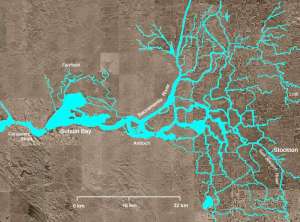 “Complaints are everywhere heard that the public good is disregarded in the conflict of rival parties.”
“Complaints are everywhere heard that the public good is disregarded in the conflict of rival parties.”
— James Madison, The Federalist, No. 10
Gilbert Cosio stands with his feet spread, one foot higher than the other, astride a sloping, 100-year-old levee surrounding Bouldin Island, 40 miles due south of Sacramento, Calif. We’re here to take a look at improvements that Cosio, a civil engineer, has made to this levee, part of a serpentine network of flood control infrastructure that was imposed piecemeal over the course of the 19th and 20th centuries on the largest estuary on the West Coast of the Americas, the Sacramento-San Joaquin River Delta.
The levee was originally made from dirt that Chinese “coolies” dredged from the swamp to carve out cheap farmland for California’s new white settlers. Today, it and the hundreds of Delta levees like it must do more: They must — as they’ve been doing since the 1850s — keep the water out of the farms, many of which have fallen below sea level because of soil subsidence. But they must also keep San Francisco Bay, contiguous to the Delta’s western edge, from flowing into the Delta. The miles of levees surrounding Delta land also confine the estuary itself, creating a quasi-natural reservoir for freshwater that’s pumped to 28 million people and billions of dollars of croplands, from Silicon Valley to San Diego. And the levees don’t just protect farms and the estuary; they keep cities and suburbs and crucial infrastructure dry.
Read more…
30 Nov 2010
by Trager Water Report
in CA Delta
Tags: California, California water, conservation, Delta
 On the heels of the withdrawal of support for the Bay Delta Conservation Plan by Westlands Water District, the San Luis & Delta-Mendota Water Authority has voted to suspend continued funding for the plan.
On the heels of the withdrawal of support for the Bay Delta Conservation Plan by Westlands Water District, the San Luis & Delta-Mendota Water Authority has voted to suspend continued funding for the plan.
The authority, which serves 29 member agencies throughout the Bay-Delta, and other public water agencies that rely on water supplies pumped through the Delta, have invested almost $150 million and more than four years toward the plan’s development. It’s estimated it will cost another $100 million to complete the plan, according to the authority.
According to the agencies, federal regulations have reduced California’s public water supplies by more than a third in the past three years and now the Department of the Interior is proposing even more regulatory restrictions.
Read More…
29 Nov 2010
by Trager Water Report
in Shortage of Water
Tags: California, California water, Delta, drought, immigration, shortage of water
 WASHINGTON, Nov. 29, 2010 /PRNewswire-USNewswire/ — The looming water crisis in the American Southwest – and the role of immigration-driven population growth – is the topic of a paper published this month by the Center for Immigration Studies and authored by New Mexico journalist Kathleene Parker.
WASHINGTON, Nov. 29, 2010 /PRNewswire-USNewswire/ — The looming water crisis in the American Southwest – and the role of immigration-driven population growth – is the topic of a paper published this month by the Center for Immigration Studies and authored by New Mexico journalist Kathleene Parker.
The paper, “Population, Immigration, and the Drying of the American Southwest,” online at http://cis.org/southwest-water-population-growth, explores the link between the possibility of the potentially catastrophic economic and environmental water crisis and the fact that the Southwest is the fastest-growing region of the world’s fourth-fastest-growing nation – a growth rate earlier cautioned against by various presidential commissions. It also looks at how that growth rate is driven by historically unprecedented immigration – legal and illegal – into the United States, the world’s third-most-populous nation after China and India. Immigration is responsible for more than half of the population growth in the Southwest this past decade, and nearly all of the growth in the largest southwest state, California.
Such high immigration has happened absent discussion or acknowledgement of its impacts on population or limited resources, such as water. Parker presents evidence that indicates there is insufficient water for the region’s current population, much less the larger future populations that will result if immigration continues at its present high rate.
Read more: http://www.sacbee.com/2010/11/29/3218296/population-immigration-and-the.html#ixzz16inTPvbZ
29 Nov 2010
by Trager Water Report
in Gov. Jerry Brown
Tags: California, California water, Delta, Jerry Brown
 During the campaign, Jerry Brown was fairly vague on what he would do as governor, especially on how he would resolve the state’s chronic budget problems.
During the campaign, Jerry Brown was fairly vague on what he would do as governor, especially on how he would resolve the state’s chronic budget problems.
“It will evolve,” one of Brown’s pet phrases from his first governorship, was the unspoken credo of the campaign for his second.
There was, however, a notable exception to Brown’s vagueness – water. He published a fairly specific policy paper on water, reflecting his own extensive experience with its complicated politics.
As governor three decades ago, Brown attempted to complete the State Water Plan that his father launched in the 1960s. The system that gathers water from as far north as Mount Shasta and transports it as far south as San Diego had – and still has – one troublesome choke point: the Sacramento-San Joaquin Delta.
Read more: http://www.sacbee.com/2010/11/28/3216216/dan-walters-water-still-on-agenda.html#ixzz16imhnmap
29 Nov 2010
by Trager Water Report
in Invasive species
Tags: Bay Area, California, California water, Delta, invasive species
 CROCKETT — Twenty feet below the water line, in the bilge of a cargo ship unloading raw sugar at the C&H factory, scientists are testing a high-tech weapon in the fight against invasive aquatic species.
CROCKETT — Twenty feet below the water line, in the bilge of a cargo ship unloading raw sugar at the C&H factory, scientists are testing a high-tech weapon in the fight against invasive aquatic species.
A special ballast water treatment system is purifying the water that whooshes through a pump from the Carquinez Strait into the Moku Pahu, a double-hull bulk carrier that ferries raw sugar from Hawaii to California.
The ballast water balances the ship as the system removes organisms thinner than the width of a hair. If the treatment system performs as expected, it will join a handful of emerging technologies that represent the shipping industry’s best hope for meeting a state deadline to remove exotic species from ballast water discharge — or face stiff penalties.
Read more…
29 Nov 2010
by Trager Water Report
in CA Delta
Tags: bypass, California water, Delta, water
 Nearly three decades after a proposed delta bypass was killed by voters in a divisive initiative battle, the idea is back in vogue.
Nearly three decades after a proposed delta bypass was killed by voters in a divisive initiative battle, the idea is back in vogue.
Pumping water from the delta’s southern edge has helped shove the West Coast’s largest estuary into ecological free fall, devastating its native fish populations and triggering endangered species protections that have tightened the spigot to San Joaquin Valley farms and Southern California cities.
The mounting delta problems, along with the potential threats of a rise in sea level and a major earthquake, have turned the attention of state and federal agencies to an “alternative conveyance”: either a canal or, more likely, a 40-mile water tunnel system that would be the nation’s longest, some 150 feet beneath the delta.
Read more: http://www.sanluisobispo.com/2010/11/29/1387624/california-looks-for-a-way-to.html#ixzz16h8ZZgEK
23 Nov 2010
by Trager Water Report
in CA Delta
Tags: California, California water, Delta, peripheral canal
 By John McCamman
By John McCamman
In 1965 the director of the Department of Fish and Game, Walter T. Shannon, presented his annual report to the Fish and Game Commission. In that report, he noted the “significant accomplishment” of selecting the peripheral canal “as the best method of transporting water from the north to the south across the Delta.”
This conclusion was the product of the “Delta Fish and Wildlife Protection Study,” a joint federal-state project that evaluated alternatives to enhance wildlife protections in the Sacramento-San Joaquin Delta. In fact, that report concludes that the peripheral canal is “the only opportunity to both protect and enhance these resources.”
There has been no change in that position, or in the relative benefits of the peripheral canal when compared to other options for the export of water since that time.
If the state and federal governments continue to export water from the Delta, the fishery agencies’ obligation is to ensure that those exports will do the least damage, and may provide an opportunity to conserve and enhance natural communities, including the fish, wildlife and habitat that are a part of those communities.
Read more: http://www.sacbee.com/2010/11/21/3199366/viewpoints-peripheral-canal-can.html#ixzz169gus7kw
19 Nov 2010
by Trager Water Report
in CA Delta
Tags: California, California water, conservation, Delta, The Bay Instute
 NOVATO, Calif., Nov. 19, 2010 /PRNewswire/ — Yesterday, the Bay Delta Conservation Plan (BDCP) Steering Committee received a document describing results of four years of work to develop a comprehensive habitat conservation plan to protect and recover endangered species and provide for a reliable water supply from the Sacramento-San Joaquin Delta.
NOVATO, Calif., Nov. 19, 2010 /PRNewswire/ — Yesterday, the Bay Delta Conservation Plan (BDCP) Steering Committee received a document describing results of four years of work to develop a comprehensive habitat conservation plan to protect and recover endangered species and provide for a reliable water supply from the Sacramento-San Joaquin Delta.
The Bay Institute, which as a member of the Steering Committee advocated for transparent development of a plan based on science, expressed disappointment with the progress to date and the content of the document.
While The Bay Institute believes that the BDCP has made substantial progress, the document received yesterday does not accurately reflect that progress as many sections describe plan elements that are not agreed to by Steering Committee members. Said The Bay Institute’s Executive Director and Chief Scientist, Dr. Christina Swanson, “Every chapter of this so-called ‘draft plan’ is prefaced by lengthy caveats and disclaimers, but even those can’t gloss over the very serious, systemic flaws with the document and its development to date. Development of a plan that will withstand scientific and regulatory review will require significant additional work.”
Read more…
http://www.prnewswire.com/news-releases/more-work-needed-for-bay-delta-conservation-plan-109237724.html
09 Nov 2010
by Trager Water Report
in SF Bay
Tags: California, California water, conference, Delta, meeting, San Francisco
 “We are thrilled to announce the first in a series of WaterTap gatherings in San Francisco. Hosted by Imagine H2O, WaterTap Happy Hour will convene and grow a community of entrepreneurs, investors, and other stakeholders interested in solving the challenges of water. Imagine H2O aims to build the ecosystem that will enable water entrepreneurship to thrive.
“We are thrilled to announce the first in a series of WaterTap gatherings in San Francisco. Hosted by Imagine H2O, WaterTap Happy Hour will convene and grow a community of entrepreneurs, investors, and other stakeholders interested in solving the challenges of water. Imagine H2O aims to build the ecosystem that will enable water entrepreneurship to thrive.
At WaterTap you can:
-Meet a lively group of passionate folks working to change the world
-Enjoy happy hour at one of San Francisco’s most popular venues
-Find collaborators, investors, mentors, feedback, ideas, and overall good company
-Learn about the Imagine H2O Water-Energy Nexus business plan competition, which will close on Nov 15th
Read more…
02 Nov 2010
by Trager Water Report
in Use of water
Tags: California, California water, Delta, Metropolitan Water District
 By JANET ZIMMERMAN
By JANET ZIMMERMAN
The Press-Enterprise
Southern California’s water supply improved enough this year that the region’s largest wholesaler is considering lifting restrictions through 2012 so local districts won’t be subject to penalties for using excess water.
The board of the Metropolitan Water District of Southern California will get a supply update during its Nov. 9 meeting in Los Angeles. Directors are expected to vote next month on whether to end mandatory 10 percent reductions.
Metropolitan’s regional water storage is showing “a significant recovery,” with about 1.6 million acre-feet expected in storage by the start of next year, 600,000 acre-feet more than last January, according to board documents. One acre-foot of water is enough to supply about two families for a year.
Read more…
26 Oct 2010
by Trager Water Report
in CA Delta
Tags: California, California water, California Water Project, Delta
 The California Departments of Water Resources and Fish and Game have agreed to jointly work on ways to restore the fish populations in the Sacramento-San Joaquin Delta and Suisun Marsh.
The California Departments of Water Resources and Fish and Game have agreed to jointly work on ways to restore the fish populations in the Sacramento-San Joaquin Delta and Suisun Marsh.
The goal will be to mitigate State Water Project impacts on sensitive fish species in the Delta by improving habitat and favorable conditions to benefit key native fish species, including the Delta smelt, the agencies say.
“The signing of this agreement is a wonderful step for conservation in California,” says DFG Director John McCamman. “It will mean that we can step up our restoration efforts for endangered Delta species.”
Read more…
18 Oct 2010
by Trager Water Report
in CA Delta
Tags: California, California water, Delta, Jerry Brown, peripheral canal
 Democratic gubernatorial candidate Jerry Brown hasn’t changed his mind about the peripheral canal, which voters defeated when he was governor in 1982.
Democratic gubernatorial candidate Jerry Brown hasn’t changed his mind about the peripheral canal, which voters defeated when he was governor in 1982.
A water plan he released Wednesday calls for building a canal or tunnel around the Sacramento-San Joaquin Delta as a way to more efficiently funnel water to Southern California and Central Valley farmers.
If elected governor, Brown says he would take action to restore the delta’s ecosystem while meeting California’s water needs.
Read more…
15 Oct 2010
by Trager Water Report
in CA Delta
Tags: California, California water, Delta, farmers, federal water
 More federal water will be on the way to valley farmers in the future thanks to a new project.
More federal water will be on the way to valley farmers in the future thanks to a new project.
A number of federal and state leaders were on hand Thursday in Tracy, to break ground on the water system improvement project called “the intertie”.
The $28 million project will connect the Delta–Mendota Canal to the California Aqueduct, to help move water.
The distance between the canals is only about 500 feet, between the intersections of Interstates 580 and 205, which is where the intertie will be built.
State leaders say this is just the beginning of what farmers, and Californians, need to sustain an adequate water supply.
Read more…
15 Oct 2010
by Trager Water Report
in CA Delta
Tags: California, California water, canal, Delta, farmers
 TRACY, California, October 14, 2010 (ENS) – A host of federal, state and local officials and business leaders today celebrated the start of construction on a $28 million underground link between two Central Valley canals south of the Sacramento-San Joaquin River Delta.
TRACY, California, October 14, 2010 (ENS) – A host of federal, state and local officials and business leaders today celebrated the start of construction on a $28 million underground link between two Central Valley canals south of the Sacramento-San Joaquin River Delta.
When complete in 2012, the Delta-Mendota Canal/California Aqueduct Intertie project is expected to improve water supply reliability south of the Delta, one of the world’s most productive agricultural regions, which relies on irrigation to grow fruits, nuts and vegetables.
The Intertie is located in an unincorporated area of the San Joaquin Valley in Alameda County, west of the city of Tracy. The site is in a rural agricultural area that is owned by the state and federal governments.
Read more…
Previous Older Entries
 The powerful Westlands Water District recently withdrew its support for the Bay-Delta Conservation Plan, action that might light a fire under other water organizations in the state.
The powerful Westlands Water District recently withdrew its support for the Bay-Delta Conservation Plan, action that might light a fire under other water organizations in the state.
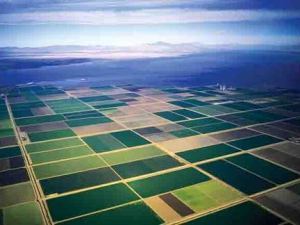


















Recent Comments